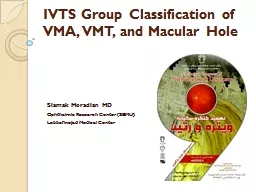PPT-IVTS Group Classification of
Author : caitlin | Published Date : 2022-04-06
VMA VMT and Macular Hole Siamak Moradian MD Ophthalmic Research Center SBMU Labbafinejad Medical Center 582016 IVTS Group Classification Dr Moradian 2 The purpose
Presentation Embed Code
Download Presentation
Download Presentation The PPT/PDF document "IVTS Group Classification of" is the property of its rightful owner. Permission is granted to download and print the materials on this website for personal, non-commercial use only, and to display it on your personal computer provided you do not modify the materials and that you retain all copyright notices contained in the materials. By downloading content from our website, you accept the terms of this agreement.
IVTS Group Classification of: Transcript
Download Rules Of Document
"IVTS Group Classification of"The content belongs to its owner. You may download and print it for personal use, without modification, and keep all copyright notices. By downloading, you agree to these terms.
Related Documents














